article and photographs by Richard Carleton Hacker
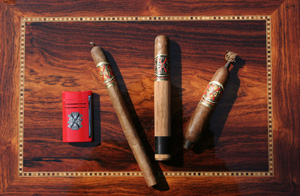
The scarce Fuente Fuente OpusX becomes even rarer with exclusive shapes, such as (l. to r.) Lancero with twisted head; black-banded Forbidden X; and the LBMF. Shown with a S.T. Dupont X-Tend butane OpusX laser jet lighter. |
Time was, there were only two kinds of cigars, inexpensive short filler, machine made stogies, and the slightly more expensive, handmade, long filler smokes. Then came premium cigars, which were not only handrolled, but were made with more expensive tobaccos and consequently, were priced higher than non-premium, handrolled cigars.
But with the cigar boom of the 1990s came an even loftier category, the non-Cuban super premium cigar, often costing as much — or more than — Havanas themselves. Indeed, many super-premiums often broke the $20 to $30 price barriers by virtue of their costlier tobaccos and limited production. One of the first that I can recall was the Davidoff Aniversario No. 1, an 8 2/3 x 48 Giant Double Corona that came in a cedar tube and tipped the scales at $30. Of course, for that price, you got an exceedingly mild and creamy smoke (belying the No.1s imposing length) that could easily last an hour and a half. And the cedar tube was a great après-smoke case for transporting lesser-sized cigars afterwards. But Davidoff notwithstanding, many super-premiums were often victims (along with the connoisseurs who bought them) of surcharges that many retailers slapped onto their "suggested retail price" simply because demand dramatically outweighed supply.
One now-classic example is the Fuente Fuente OpusX. I will never forget being told by a high roller I met in one of the cocktail lounges in Las Vegas a few years ago that he was about to light up a $100 cigar. Being more than a little curious as to just what such a cigar might be, I asked to see it and was proudly shown an OpusX, which at that time carried a suggested retail price by the Fuentes of $18.75. When I asked where he had obtained his C-Note cigar, he led me to a cigar shop that was indeed selling the OpusX for $100 apiece. If you wanted to smoke that cigar in that town that night, that was the going price.
Another, less-gouging example of the new super-premiums during the cigar boom occurred during the introduction of the J.C. Newman Diamond Crown. These cigars were so difficult to obtain that retailers were asked to limit their customers to just two cigars each. Of course, it didn't take much imagination for serious and well-heeled lovers of the leaf to assemble eight friends and voilá! — you had one more cigar than a full box (Diamond Crowns come 15 to a box). Thus, pricing and scarcity, as well as superior tobacco and construction, came to signify a super premium cigar.
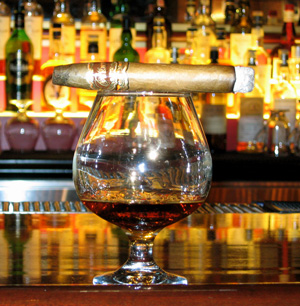
With its Cameroon wrapper and OpusX filler (a guarded secret, as only four rollers are allowed to make it), Casa Fuente is one of the most exclusive cigars in the world. It is only available at Casa Fuente in Las Vegas. Six shapes are made, including a newly released double corona and a pyramid (shown). Photographed by the author at Casa Fuente. |
But now there is an entirely new category that has recently emerged, one which I have christened The Ultra Cigar. These hand-made rarities have all of the attributes of super-premium cigars — top graded tobaccos, extra aging, and higher prices - but one of the things that helps differentiate them from the rest of the pack is what the movie industry calls "a back story." That is, there is a sub-plot behind the cigars themselves. They have a raison d'état — a reason for existing, or at least for being made. It may be to commemorate an event, a person, or a certain type of highly coveted tobacco. And by virtue of this, Ultra Cigars are almost always limited editions or at best, are on allocation to tobacconists. Thus, they are usually very difficult to locate, although the internet has made sleuthing out these stellar stogies a lot less frustrating than it was a decade ago.
Ultra Cigars could actually be said to have started with the Padrón Millennium Humidor in 2000, in which 1,000 numbered humidors were produced, each holding 99 cigars that were individually numbered on their bands. Initially each humidor retailed for $3,000. But just last year, while visiting the Bacardi distillery in Puerto Rico, I stopped into one of San Juan's best cigar shops, The Doll House, and saw one of these rare humidors in the window and priced at $5,000. And that was just for the humidor - without the cigars!
And a few years ago, Camacho came out with their annual Liberty series of cigars, created by Julio Eiroa and incorporating a portion of pre-embargo Cuban leaf in the filler recipe. Needless to say, these cigars are always an instant sellout, with this year's offering being a little milder tasting than in the past. The 2006 Liberty edition features a Cameroon wrapper, with a portion of the mostly Honduran filler containing some 44-year old pre-Castro Pele de Oro Cuban leaf from the old DWG Cigar Company warehouse stocks that were uncovered in Lima, Ohio a few years back. Only 2,000 patriotically colored blue, white and red wooden chests were produced for 2006, each carrying 20 individually-boxed and numbered cigars, which sell for $14 apiece, or $280 for a full chest.
But these and similar cigars, such as the Perdomo Edición de Silvio, which came out in 2004, were isolated offerings that collectively, started to slowly build into a trend. In reality, 2006 was the pivotal year in which the Ultra Cigar category actually became a separate classification of its own. The impetus for this honor actually goes to four cigars, all of which were introduced in the fall of that year — J.C. Newman's Stanford's 90th, the Fuente Don Carlos Edición de Aniversario, Davidoff's Diademas Finas, and Ashton's ESG (Estate Sun Grown). Fittingly, three of these Ultra Cigars were created to honor notable cigar industry individuals.
Stanford's 90th Diamond Crown Maximus was created by the J.C. Newman Company to pay tribute to Stanford Newman, the firm's reigning icon, who turned 90 in June 2006, making him the oldest living cigar professional in the business. Unfortunately, Stanford passed away just two months later, but thankfully he lived to see the cigar that now stands as a tribute to a man who started out during the Great Depression handrolling perfectos in the barn behind his parent's house.
Stanford's 90th, like all J.C. Newman premium cigars, was created by Stanford's sons, Eric and Bobby, and their long-time friends the Fuentes in the Dominican Republic. It uses the Diamond Crown Maximus as its base, but then it takes the Maximus to the max. Instead of the Ecuadorian sun-grown leaf found in the regular Maximus, Stanford's 90th features an incredibly rich and smooth smoking eighteen-year old West Africa's Cameroon wrapper grown by the legendary Meerappfel family. This is especially symbolic, for Stanford was the first to import Cameroon wrappers into the United States after the Cuban embargo. To complement this rare wrapper, the Maximus Dominican filler has been reblended to lend just a touch more sweetness to the flavor.
Only one size of Stanford's 90th is being made, a 7x48 churchill, which was Stanford's favorite shape. There will be one thousand leather-covered presentation boxes available, each containing 20 cigars. Only 850 boxes will be sold in the U.S., with an additional fifty going to international markets, and a remaining one hundred reserved for the Cigar Family Charitable Foundation fund raisers. Lighting up a Stanford's 90th is the perfect way to pay tribute to one of America's premier cigar pioneers.
Another cigar industry icon being honored with his own cigar is Carlos Fuente, Sr., inspiration for the full-of-flavor Don Carlos cigar, one of the world's first "vintage" smokes, as every cigar is aged for over a year. Originally introduced in 1976, it disappeared when the Sandinistas took over the Fuente factory in Nicaragua, but was brought back when the family re-established their cigar making operations in the Dominican Republic in 1980.
But the new Don Carlos Edición de Aniversario is dramatically different than the Cameroon-wrapped Don Carlos. Although it features a slightly similar Dominican filler and binder (a cross between the regular Don Carlos blend and that of the OpusX), the wrapper has been changed to leaf from the famed Chateau de la Fuente, making this very special version of the Don Carlos an all-Dominican puro. There are three shapes — a 5 1/4 x 50 robusto, a 5 3/4 x 52 double robusto, and a 6 1/4 x 48 toro. Only one thousand cigars of each shape will be produced, for a grand total of 3,000. The Don Carlos Edición de Aniversario will be presented in a special three-tray, 30-cigar humidor of ten cigars of each of the three shapes. Also available with each purchase will be a biography of Don Carlos, written by yours truly.
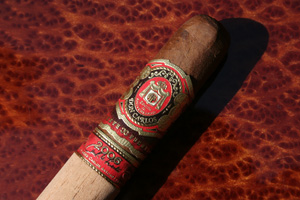
The double banded Don Carlos Edición Aniversario was created as a Dominican puro by Carlito Fuente to honor his father, Don Carlos Arturo Fuente. |
"This is something from the heart, that I wanted to do for my father," Carlito told me of the special cigar he had created. "It's not a regular Don Carlos cigar; it's a special version of his cigar that I am making in tribute to my father, but made 'Carlito's way.' It's a little spice with a little silent undercurrent that if you're not careful, it's going to knock you off your feet. The whole theme is that I want to pay tribute to my father, my hero, Carlos Arturo Fuente. The cigar is his love, Chateau de la Fuente is my love, so I have combined the two together to create this special cigar for him."
Our third Ultra Cigar also pays tribute to a man whose name is literally synonymous with the finest of cigars, Zino Davidoff. Zino was born in Kiev, Ukraine, Russia on March 11, 1906, the son of a Geneva tobacconist. He went on to became the first person to have a privately produced cigar sanctioned by the Cuban government for export. Eventually, through the auspices of the recently retired Dr. Ernest Schneider, Zino saw his name become the cornerstone of cigar smoking elegance and excellence, and when Cuba ceased to meet his demands for quality, he shifted production to the Dominican Republic.
Although Zino passed away in 1994 at the age of 88, Oettinger Davidoff Group, the worldwide firm that heralds his name, honored the 100th anniversary of Zino's birth with a special limited production cigar, the Diademas Finas. This 6-3/4 x 50 unbanded and uncellophaned perfecto is handrolled in the image of the very first Cuban "chateau" shapes Davidoff created in 1948. The tobaccos are aged from between three to five years, and the filler is composed of five different Dominican tobaccos. The cigars are available at Davidoff "appointed merchants" worldwide.
Only produced during 2006, the Diademas Finas are sold in "display" boxes of ten each; the lid of the box (the first label-covered box in Davidoff's history) features a 1940s sepia photograph of a nattily dressed Zino in front of his Geneva store, which was only a few blocks from the corner where Davidoff's current Geneva store is located.
Of even greater scarcity is the Diademas 100, a larger 9 1/8 x 55 version of the Diademas Finas; it is only rolled by factory supervisors, and because of its difficult shape, output is limited to just 100 cigars a day. All of the tobaccos are from the 1992 and 1993 harvests, two of the best on record. The cigars are tied in bundled "wheels" of fifty and placed in cedar cabinet boxes. They are only available at Davidoff company stores (two in Manhattan and five in Las Vegas).
"The real difference between the two cigars," says Davidoff's master blender, Hendrik "Henki" Kelner, "is the age of the tobacco we used. The Diademas Finas tobaccos are aged between three and four years, but with the Diademas 100, the tobacco has between seven to thirteen years of aging. (But) it's not only because of the special quality of this tobacco," says Henki, who had worked with Zino since 1990, "but also because it has a sentimental value, because maybe some of this leaf Zino actually touched with his hands."
And finally, we have the Ashton VSG, which stands for Virgin Sun Grown. It, like the Don Carlos Edición de Aniversario, is a Dominican puro, although for some reason, no one initially picked up on this, either on the internet nor in tobacco shops. So I guess you can say you read it here first. But the fact is, Carlito Fuente created a rock 'em-sock 'em wrapper-binder-filler combination that was set up to challenge the already-thundering Ashton VSG (Virgin Sun Grown). Fugettaboutit. The VSG stands on its own as the deepest, mellowest stogie out there right now. But what the ESG has to offer is a sharp rabbit punch to the taste buds, with a sun-grown Chateau de la Fuente wrapper created just for this cigar. And it is only being offered in a 6 3/4 x 49 size. However, next year a 5 1/4 x 52 will be unveiled, followed by a different shape each of the following three years, culminating in 2010, when Ashton will celebrate its 25th anniversary.
But this is only the beginning of the Ultra Cigars. For example, there is the ultra-rare Casa Fuente stogies that are only available at the Casa Fuente cigar boutique at The Forum Shops at Caesar's Palace in Las Vegas. If you want people to know you've been to Sin City, just flash this band around the cocktail lounge in Iowa. And keen-eyed observers might spot the special 1980-2005 band on the special Davidoff cigar that you can only get at Edward Sahakian's Davidoff store on Jermyn Street in London. This mild-mannered smoke has a special blend to commemorate this famous smokeshop's 25th anniversary. And as if the OpusX wasn't rare enough, now there are ultra shapes to go along with this Ultra Cigar.
Indeed, the game of one-ultramanship has only just begun.
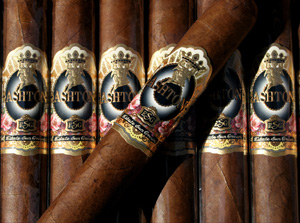
Ashton's ESG (Estate Sun Grown) is a Dominican puro that packs a punch. |
|
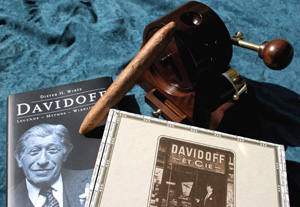
To pay tribute to the anniversary of Zino Davidoff's 100th birthday, a limited edition Diademas Finas perfecto was produced in 2006, shown with an Altadis Cigar Savor 3-Way Cat's Eye Cutter that also makes a guillotine and pierce cut. Also shown is Zino Davidoff's authorized biography (depicted in a German first edition; an American edition is also available). The Diademas Finas display box features a 1940s vintage photograph of Zino. |
|
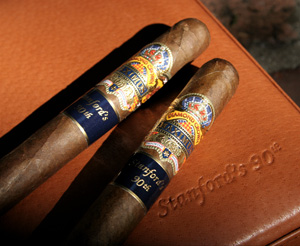
Stanford's 90th Diamond Crown Maximus features an 18-Year-old Cameroon wrapper and comes in a leather presentation box, of which only 850 are available in the United States. |
|
|
|